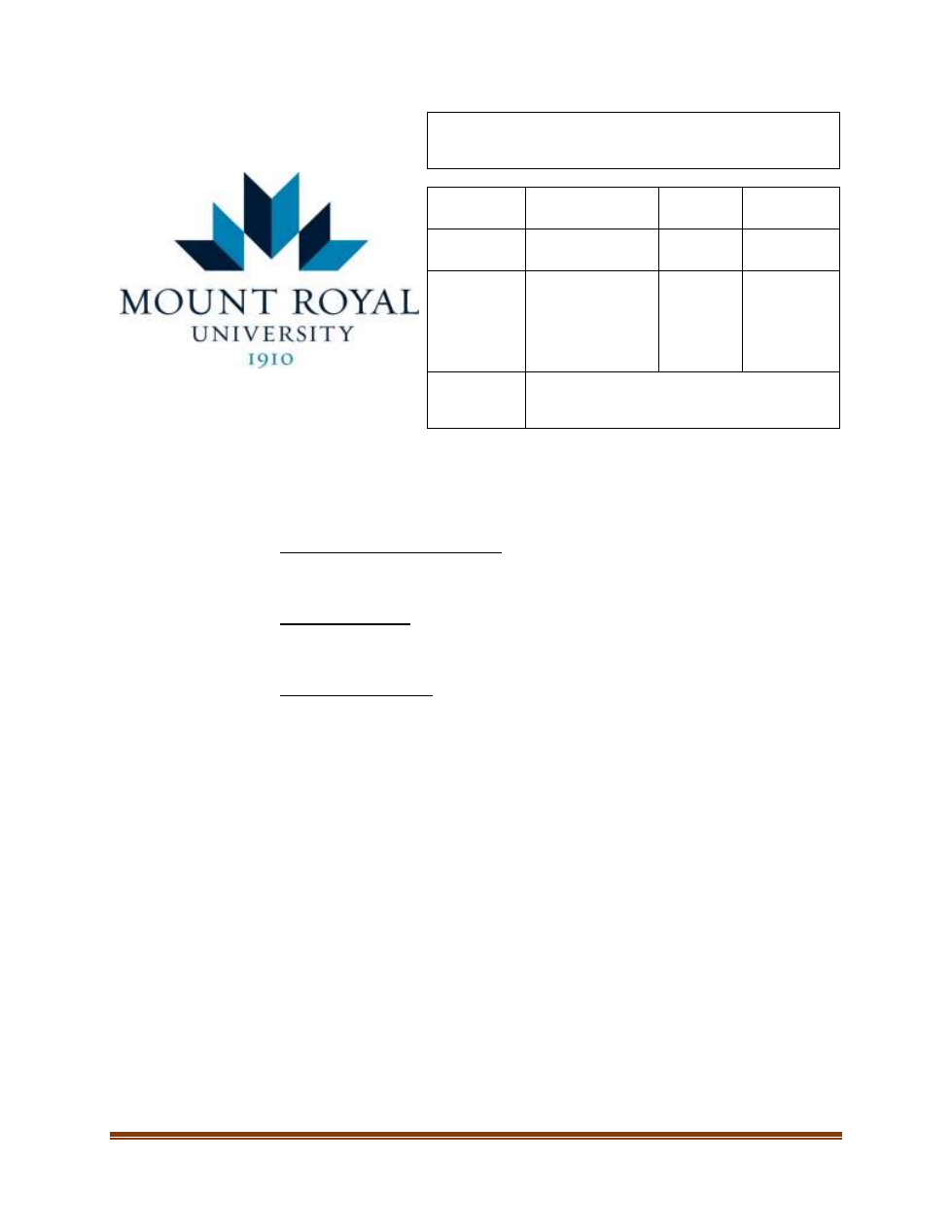
Biosafety Management Procedures
– April 4, 2011
Page 1 of 4
BIOSAFETY MANAGEMENT PROCEDURES
Procedure
Type:
Management
Initially
Approved:
April 4, 2011
Procedure
Sponsor:
Provost and Vice-
Provost, Academic
Last
Revised:
April 2011
Administrative
Responsibility:
AVP, Research,
Scholarship and
Community
Engagement; and,
Office of
Occupational Health
and Safety
Review
Scheduled:
April 2024
Approver:
Executive Leadership Team
A.
PROCEDURES
1.
RESPONSIBILITIES
1.1
The Office of Research Services shall ensure that research funds are not released
until the appropriate biosafety certification has been submitted and approved by
the Biosafety Committee.
1.2
Department Chairs shall ensure that facilities and activities related to biosafety are
approved by the Biosafety Officer prior to the start of teaching projects involving
Biohazardous Materials.
1.3
Principal Investigators shall:
a.
Apply to the Biosafety Committee before commencing work with
Biohazardous Materials.
b.
Arrange for facilities and equipment necessary to meet the required level
of containment and other recommendations of the Biosafety Officer.
c.
Ensure for appropriate training as prescribed by the Biosafety Committee.
d.
Ensure that staff and students are aware of any required medical
surveillance.
e.
Ensure that prescribed procedures are followed to ensure that
Biohazardous Materials are properly stored and/or destroyed, that
contamination is controlled, and that the laboratory is secure against
unauthorized access at all times.
f.
Ensure that the Biosafety Officer is immediately informed of any laboratory
incident involving Biohazardous Material.
g.
Ensure compliance with the requirements of Health Canada permits, the
Canadian Food Inspection Agency permits, and the Transportation of
Dangerous Goods Act and regulations.

Biosafety Management Procedures
– April 4, 2011
Page 2 of 4
1.4
The Biosafety Committee shall:
a.
develop a comprehensive health and safety program for all work deemed
to constitute a biohazard;
b.
approve biohazard projects;
c.
identify and approve for biosafety all activities involving Biohazardous
Materials;
d.
review annually the Biosafety Program.
1.5
The Biosafety Officer shall:
a.
serve as a resource for the Biosafety Committee;
b.
audit teaching and research laboratories for compliance with biosafety
requirements, established safety procedures, and performance of safety
containment equipment;
c.
maintain files for biohazard certification, biocontainment certification, and
special emergency procedures for each project;
d.
maintain and provide information on Biohazardous Materials, policy and
procedures, safety equipment, personnel training material, regulations
and guidelines, and contingency and decontamination procedures for
Biohazardous Materials when available;
e.
order, immediately, the suspension of any activity involving the use of
Biohazardous Material when there is reason to suspect the health and
safety of University personnel and/or the public are at risk or that
regulatory conditions of the project have been breached;
f.
review with the Biosafety Committee any ordered suspension of activity.
1.6
Faculty/Staff and Students shall:
a.
comply with all conditions outlined in the biosafety certification form;
b.
report any unsafe conditions and procedures to the Principal Investigator
and the Biosafety Officer;
c.
report any illness suspected of being related to work with Biohazardous
Materials to the Principal Investigator and the Biosafety Officer;
d.
participate in biosafety training and spills mitigation.
2.
TRAINING
2.1
Wherever applicable, awareness of the Biosafety Program will be included in new
employee and student orientation. The responsibility for providing this orientation
and for ensuring that generic guidelines are understood and specific procedures
are followed belongs to the supervising faculty member. Deans, Chairs and
Directors have the responsibility for ensuring that faculty members carry out the
requirements of this section.

Biosafety Management Procedures
– April 4, 2011
Page 3 of 4
2.2
Additional information for the Biosafety (General Laboratory Procedures
Containment Level 1 and Level 2, and application guidelines and forms) are
available by contacting the Biosafety Officer.
3.
MANAGEMENT OF NON-COMPLIANCE WITH THIS POLICY
3.1
Mount Royal University's Biosafety Committee is responsible for post-approval
monitoring of biosafety protocols and for determining and working to correct
breaches of compliance. Breaches of compliance that cannot be corrected by the
Biosafety Committee will be referred to the Biosafety Officer.
3.2
When an allegation of non-compliance is made, the Biosafety Officer shall
investigate the matter and determine whether the allegation is valid. This may
involve comparing the approved protocol or standard operating procedures
approved by the Biosafety Committee with the alleged activities. In cases where
the allegation is found to be valid upon investigation, the Biosafety Officer will
proceed as follows:
a.
The Biosafety Committee will inform the Supervisor (Principal Investigator,
Instructor, Lab Manager or the involved Department Chair) in writing that
a breach in protocol has occurred and allow time to rectify the breach.
Should the written response of the Supervisor be insufficient, the Biosafety
Committee will schedule an emergency meeting.
b.
The allegation to and the response from the Supervisor will be discussed
at the emergency meeting. The Committee must then make one of the
following determinations:
i.
The response to the allegation is adequate. No further action is
required.
ii.
The response to the allegation is inadequate and the allegation
involves minimal risk (as determined by the Committee).
Recommendations must then be sent to the Supervisor and a
specified time period will be set for the issue to be resolved.
iii.
The response to the allegation is inadequate and the allegation
involves,
or
could
potentially
involve,
significant
risk.
Recommendations to suspend activities will be sent immediately
to the Biosafety Officer and to the Associate Vice-President,
Research, Scholarship and Community Engagement by the
Committee.
c.
In the event the Biosafety Officer or other designated individuals from the
committee discovers conditions which pose an immediate threat to
laboratory workers, community, or the environment, the Biosafety Officer
or one other designated individual from the Committee can recommend
immediate action to the Associate Vice-President, Research, Scholarship
and Community Engagement. The recommendation can include the
immediate suspension of the related activity.
d.
The decisions of the Committee shall be documented in writing. All
correspondence directed to the Supervisor will be copied to both the
Department Chair and the Dean.

Biosafety Management Procedures
– April 4, 2011
Page 4 of 4
e.
Recommendations
to
the
Associate
Vice-President,
Research,
Scholarship and Community Engagement shall be made in a formal letter
detailing the following:
i.
the issue;
ii.
the alleged infraction;
iii.
steps taken to resolve the issue;
iv.
recommendations of the Committee;
v.
time period for response to be made to the Committee.
B.
DEFINITIONS
(1)
Policy:
means the Biosafety Policy
(2)
University:
means Mount Royal University
C.
RELATED POLICIES
• Biosafety Policy
D.
RELATED LEGISLATION
• Alberta Occupational Health and Safety Act
• Canada Environmental Protection Act
• Canada Transportation of Dangerous Goods Act
E.
RELATED DOCUMENTS
• Biosafety Program
• Biosafety Committee Terms of Reference
• Health Canada Laboratory Biosafety Guidelines, 3
rd
Edition, 2004
• Natural Sciences and Engineering Research Council of Canada (NSERC) Guidelines
• Office of Research Services Procedures Manual
F.
REVISION HISTORY
Date
(mm,dd,yyyy)
Description of
Change
Sections
Author
(Position Title)
Approver
(Position Title)
04/04/2011
NEW
12/09/2022
Editorial
Job titles
Policy Advisor
University Secretary



